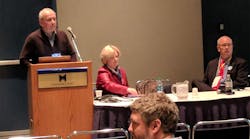Latest from AHR
Overheard in Orlando
ASHRAE Wraps AHR Expo, Winter Conference in Orlando
Sponsored
This Monday afternoon education session at AHR Expo 2018 was moderated by Ken Sinclair, owner/publisher of AutomatedBuildings.com, with Therese Sinclair of Building Context, Ltd. and Anto Budiardjo, Fractional Entrepreneur, as speakers.
What, exactly, is “the edge?” The edge is the point of contact. Where the rubber meets the road. For several years now the automation model has had devices connected with sensors out on the automation “front lines” transmitting data up to “the cloud,” where all the analytics happened, then waiting for instructions. The obvious analogy is users with their smartphones, all acting and reacting to information displayed on their devices, but with all the actual computing done on the Amazon, Google or Microsoft clouds. In this model, human beings are at the edge.
But now, both computing power and memory are compact enough and affordable enough that the decision-making is taking place out there, on the edge. Networked together those edge devices have all the power and capacity they need to run the entire building automation show.
Therese Sullivan led the discussion by asking that question to the crowd: “How do we put all these intelligent devices together for the greater good?”
The extended analogy she made was right out of Star Wars. How, she asked, is an IoT project team like the Jedi Council?
1. There are a lot of bruised egos (this one was mostly for the laughs)
2. It is multi-disciplinary
3. It requires both an open philosophy and a strong sense of partnership
The building automation industry is now in the middle of a great convergence, between operations technology and enterprise I.T. As the era of the personal computer fades, a new service-oriented model will predominate.
Anto Budiardjo opened his remarks by describing the latest initiative from the Continental Automated Buildings Association (CABA), the New Deal for buildings. The New Deal consists of three primary objectives:
1. Open standards
2. Digital twin (that is to say, a digital model of the building in the cloud)
3. Service transparency
Budiardjo drew the contrast between 1980, when so many of us were listening to our music on vinyl records, and today when so many listen to their music through a web-based service like iTunes or Spotify. The same movement is happening in the BAS architecture of tomorrow. Soon, we will all be looking at our data in the cloud through the viewfinders various internet browsers provide us.
Throughout the building automation industry, the price of hardware is dropping. Much in the same way tablets have started to drive laptop computers out of the market, many automation devices are offloading non-critical functions to the cloud. For example, if you use Google Sheets, do you really need to pay for Excel? Open source software is about to collide with open source hardware, and the result could be an innovation playground for developers.
And Budiardjo was quick to put the emphasis on developers. We as consumers don’t really buy open sourced products. We need things packaged into something we can depend on, and the automation industry is going to need to create those packages, those custom-tailored systems for their end users.
The new era is not without its potential pitfalls. Security and privacy will be huge concerns on an integrated, intelligent edge. So much data about individuals will be potentially accessible, and keeping it secure will be a major concern. But make no mistake, that data will be collected; the demand for the benefits of collecting it will simply be too high.
Steve Spaulding | Editor-inChief - CONTRACTOR
Steve Spaulding is Editor-in-Chief for CONTRACTOR Magazine. He has been with the magazine since 1996, and has contributed to Radiant Living, NATE Magazine, and other Endeavor Media properties.


